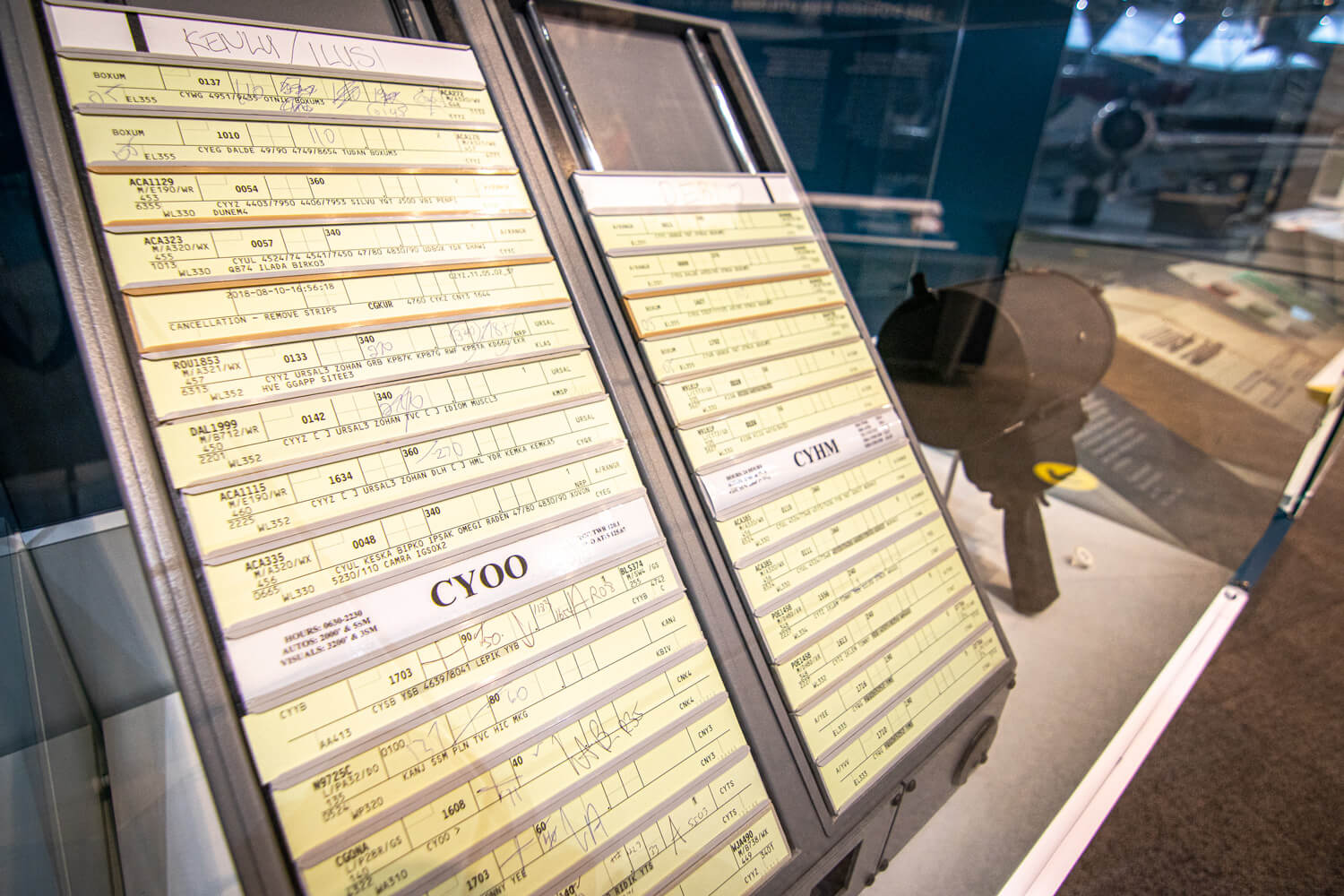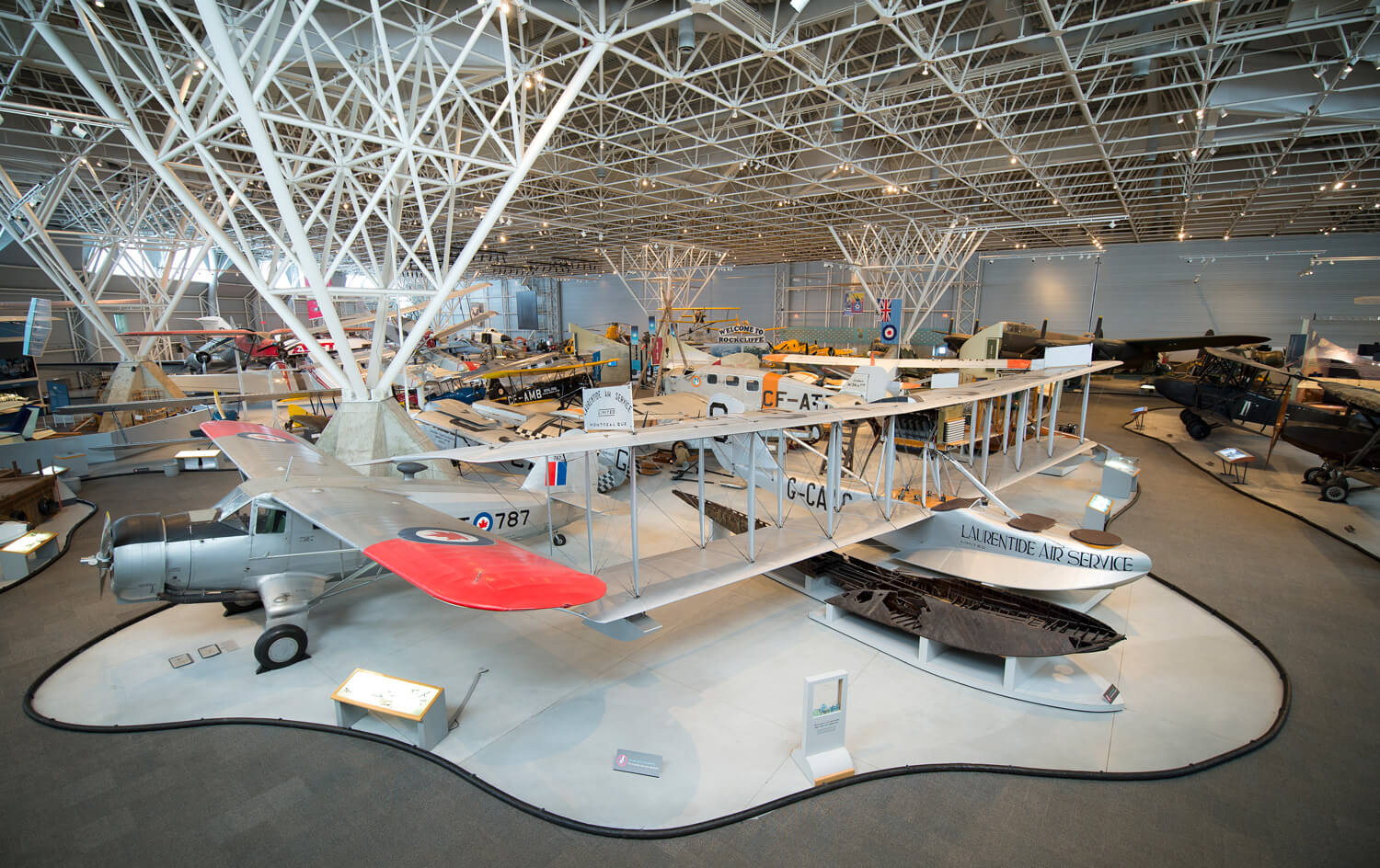







November 2, 2021
The past, present and future of air traffic management in Canada converge in new exhibitions created by Ingenium – Canada’s Museums of Science and Innovation — thanks to the contribution of stories and artifacts from current and retired NAV CANADA employees.
Featuring a behind-the-scenes look at the systems, people, and technologies that keep Canada’s skies safe, Eyes on the Skies: Managing Air Traffic in Canada is now on display at the Canada Aviation and Space Museum (CASM). A companion travelling exhibition of the same name is also now touring across Canada.
Staff at CASM have long recognized this story was missing on the museum floor so it was about finding the right opportunity to get such a project off the ground, if you’ll forgive the aviation pun. I had completed a research paper on the history of air traffic control in Canada so we weren’t completely starting from scratch in terms the research required.
It really came down to Chris Kitzan, the Canada Aviation and Space Museum’s Director General, and Ingenium's business development team, who were exploring ways to work with NAV CANADA when the idea of a partnership and exhibition was born.
That is a tough one because there are some great artifacts and stories in this exhibition! If I had to choose I think it would be between the Precision Approach Radar (PAR) console in the section that focuses on transatlantic flight and Gander, and the story of Eric Staples, a former air traffic controller who worked in so many places across the country, including Iqaluit in the late 1950s.
The console was the first PAR installed in Canada in 1959 and that was one of the few artifacts we had in the collection for the project. It’s a really cool object and I had the opportunity to interview one of the first people to qualify on it, Frank Tibbo of Gander, Newfoundland, which was really fortuitous.
I love Eric Staples’ story and am very grateful to his family (his daughter Brenda in particular) for sharing it with me and loaning artifacts for the exhibition. Beyond his licences for air traffic control (ATC) and radio and his whiz wheel, we also have photos and video footage from his time working in Iqaluit over the winter of 1957-58. Incredible! It was also really important to me to share the story of women in air traffic control, so there is a section of the exhibition devoted to that history specifically, although women are featured throughout the entire exhibition as well.

It was definitely a process and a team effort. In terms of artifacts, I got a lot of help from the team at NAV CANADA which put out a call to employees to see if there were suitable objects out there and that was very fruitful. I was also able to track down several former employees from both Transport Canada and NAV CANADA who worked in air traffic management (ATM) and I was able to secure quite a few loans out of that effort. Eyes on the Skies also features objects from other museums and cultural institutions, such as the Montreal Aviation Museum and Library and Archives Canada.
For the research and information side of things, I had some knowledge already from the research project I mentioned earlier, but I still needed to consult a lot of people from across NAV CANADA and many former employees from Transport Canada to try to work out details and ensure that I understood the workings of what is a very large and complex system.
I was lucky enough to visit some area control centres (ACCs) in Montreal, Toronto, and Gander, in addition to the training facility here in Ottawa, and a tower at Pearson Airport. I’m so grateful for those opportunities and the people who really went out of their way to help make this happen. I learned so much.

The museum has an incredible collection of aircraft – routinely counted among the best in the world. Our floor does a fantastic job of highlighting these amazing feats of technology, but it lacks the behind-the-scenes elements of aviation that make it possible for these amazing things to fly.
I think everyone takes those things for granted to a degree – they step onto a plane, leave one place and arrive at another without knowing just how many people and systems have supported that single flight. It’s a system designed to be invisible to a point and it only becomes visible when something isn’t working. With that in mind, we wanted this exhibition to showcase the air navigation system in Canada and the ways in which its incredible technology and highly trained people make it safe for everyone to fly in Canadian airspace.

This is a tough question and my answer will probably be a bit unexpected. I would have to say that the introduction of computers to air traffic management has been the most significant advancement as the use of computers have enabled so many other technologies that make flight safer. Computers processed data coming from radar units and delivers that data to consoles for controllers to use in addition to allowing for many manual tasks to be automated.
Today, computers are used for simulation programs in training, running software programs that help people working in air traffic management do their jobs more efficiently and with better tools. They are at the heart of other developments and really revolutionized the field.

Luckily for us, the “official” history of air traffic management in Canada is only 100 hundred years, 80 if you start from its formal implementation in 1939. This exhibition is broken up into broad themes that span the history of ATM in Canada: Systems, People, and Technology. Because of the small physical space we had to occupy and following proper exhibition development protocols, we can’t do a lot of deep dives on the topics so we tried to bring out the human stories as much as possible and focus on highlights rather than going step-by-step through the history. Exhibitions aren’t really for that.
They communicate specific messages about a subject in a fun and engaging way. When we felt we needed more space to communicate or that a visitor would need more information to understand a topic, we used videos and infographics. For example, we have videos which explain how radar and space-based Automatic Dependent Surveillance-Broadcast (ADS-B) work and an infographic to explain the role that Gander plays in transatlantic travel.

It was definitely a challenge. The conditions imposed by the pandemic meant that we struggled to finalize loans and image permissions because the institutions we were working with were closed like us, but didn’t have the tools to work from home in place yet.
My exhibition teammates, Erin Poulton (Interpretive Planner) and Rachelle Fournier (Project Manager) also had challenges to overcome. Our reviews were primarily digital, where we typically have physical printouts to look over and mark up. There were also supply concerns with the materials we needed to physically create the exhibition and there were many delays on the fabrication front.
There were delays all over the place actually – we were supposed to open last November, but the pandemic forced us to delay until now. So that had an impact on other team members, like Matt Bruce and Erika Range, our conservators, and Jason Robinson, who helped coordinate the installation of the exhibit and now maintains it.
There were people on the team, like myself, who were responsible for young children or other family members and the pandemic made caretaking that much more difficult and time consuming.
So yes, the pandemic impacted the work on this exhibition a great deal. It was an experience I won’t soon forget and I’m sure everyone on the team feels the same way.

I hope visitors gain a new appreciation of the whole system. Even if they don’t leave knowing any facts or remembering a specific story, I hope they will feel they understand this side of the aviation industry a little bit better.
I hope our young visitors think about what kind of jobs they might like to do in the fields we talk about throughout the exhibition or at least learn that this kind of work is out there for them to explore.
Finally, I hope that our visitors will leave feeling some pride in the great work that has been accomplished at and by NAV CANADA since 1996.

I have to say I wasn’t overly interested in aviation until I started working at the museum eight years ago. I’m still a little blown away by how quickly and deeply I fell in love with the field once I started working here. Every step I take, every project I work on, deepens that passion. I can’t even tell you how wonderful it is and how very lucky I am to work at this amazing institution with my incredible colleagues and this truly outstanding collection every day. More than that, I have the opportunity to meet the most incredible people in the industry, from astronauts to engineers to veterans to the folks on the business side of the industry. I often say that this is not a job to me, it’s a lifestyle. I never take that for granted.

Wow, I don’t really think of my work that way. I just hope to inspire others to consider what possibilities a career in this industry might hold for them. There is so much change on the horizon with urban air travel, increased drone use, and electric aircraft.
To be corny about it, the sky’s the limit.
I believe the museum can play an important role linking industry to youth, in addition to sharing the history of aviation with all Canadians. It’s also important to me personally – and our whole team at CASM – to make the content of the museum as representative as possible of the diverse people who work in this field, so visitors can find themselves in the museum and hopefully, in this industry in the future.

From July to October, the travelling exhibition was at the Alberta Aviation Museum in Edmonton, AB. Next, it will be at the Hangar Flight Museum in Calgary, AB, from November 2021 to February 2022, and the Lennox & Addington County Museum & Archives in Napanee, ON, from May to September 2023. As new tour stops are confirmed, they will be added to the Canada Aviation and Space Museum’s website.
The exhibition at the Canada Aviation and Space Museum in Ottawa is now part of the museum’s permanent collection. Current and past NAV CANADA employees played a key role in the creation of this exhibit and the impact of their contributions will be felt for generations to come.